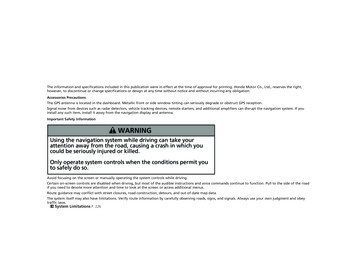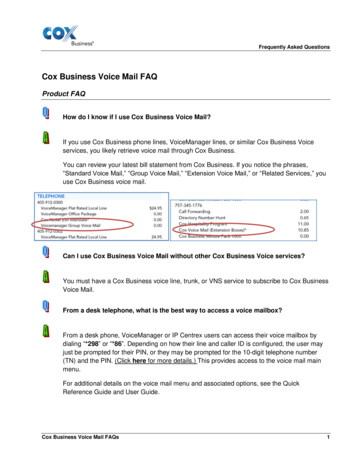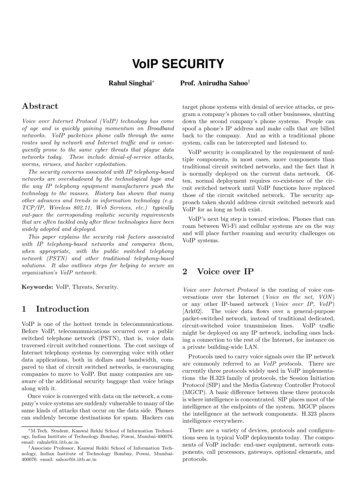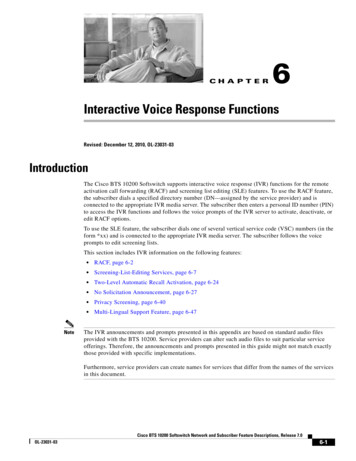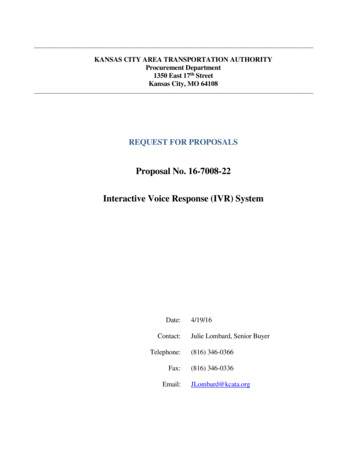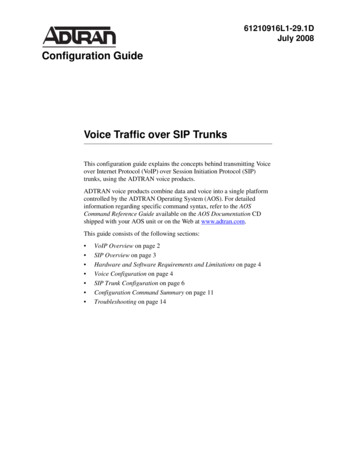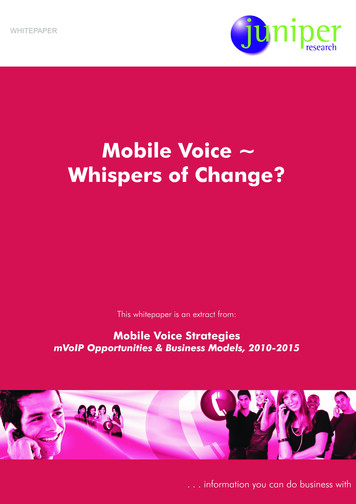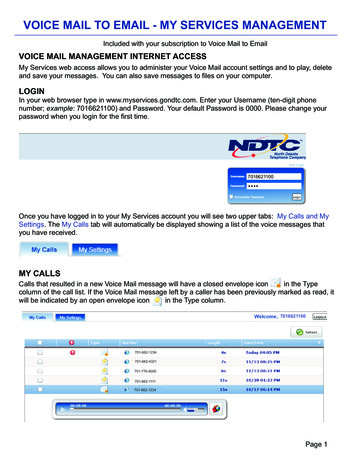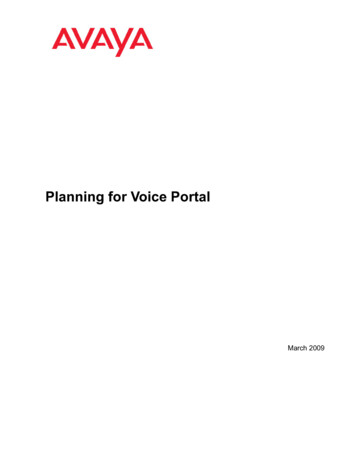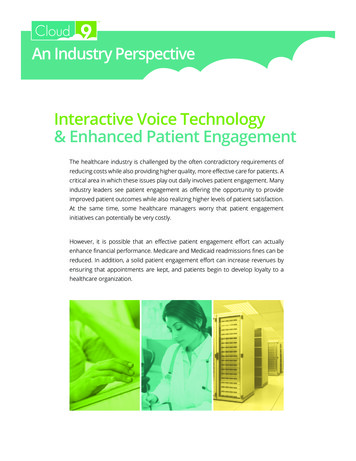
Transcription
TMAn Industry PerspectiveInteractive Voice Technology& Enhanced Patient EngagementThe healthcare industry is challenged by the often contradictory requirements ofreducing costs while also providing higher quality, more effective care for patients. Acritical area in which these issues play out daily involves patient engagement. Manyindustry leaders see patient engagement as offering the opportunity to provideimproved patient outcomes while also realizing higher levels of patient satisfaction.At the same time, some healthcare managers worry that patient engagementinitiatives can potentially be very costly.However, it is possible that an effective patient engagement effort can actuallyenhance financial performance. Medicare and Medicaid readmissions fines can bereduced. In addition, a solid patient engagement effort can increase revenues byensuring that appointments are kept, and patients begin to develop loyalty to ahealthcare organization.
The Patient Satisfaction Case for Improved Patient EngagementThe state of patient engagement has become a significant issue through all levels of the healthcare industry.A recent study by TeleVox and Kelton Research exposes both the problem of poor patient engagement andthe benefits that could accrue due to higher levels of engagement. According to the study:55% of providers say they don’t communicate with patients betweenvisits. Even more concerning, 50% of healthcare professionals believetheir job begins and ends during regular office visits.83% of Americans don’t follow treatment plans exactlyas prescribed by their doctors.42% of Americans feel they would be more likely to follow their prescribedtreatment plans if they received encouragement and coaching from theirdoctors or other healthcare providers between visits.A 2012 HCAHPS (Hospital Consumer Assessment of Healthcare Providers and Systems) studyfound that patient satisfaction correlated strongly with the following engagement elements: Understandable information about recovery – 82.72 Doctors communicating well – 80.44 Nurses communicating well – 76.55Research shows that effective engagement can significantly impact levels of patient satisfaction.2
The Financial Case for Improved Patient EngagementMost U.S. hospitals will realize reduced fundingfrom Medicare in fiscal 2016 because too manyof their patients are returning within 30 daysof discharge. According to one report, only 799out of more than 3,400 hospitals that weresubject to the Hospital Readmissions ReductionProgram performed well enough on the Centersfor Medicare & Medicaid Services’ (CMS) 30-dayreadmission program to eliminate penalties.There is good news in the fact that a numberof studies have established that consistentpatient engagement can have significant, positivefinancial implications. First of all, a quality patientengagement effort will reduce readmissions.For instance, in one study, a program of postdischarge phone calls delivered a 29 percentreduction in 30-day readmissions in patients whohad heart failure issues.The readmission prevention program, createdunder the Affordable Care Act, initially focused itsevaluation on how often patients treated for heartattack, heart failure, or pneumonia returned tothe hospital within 30 days of discharge. Facilitieswhose readmission rates were too high weredocked up to 1% of their Medicare payments infiscal 2013. This charge was increased to a 2%reduction in fiscal 2014. The rate was again raisedto 3% in 2015, with the majority of hospitalsfacing some level of fines during that reportingyear. Today, this readmissions program coversa number of other conditions including chronicobstructive pulmonary disease and total hip andtotal knee replacement.Another financial issue that can be effectivelyaddressed via improved patient engagement ismissed appointments. While the frequency ofmissed appointments vary with patient conditionsand the type of practice, most healthcareorganizations are dealing with 5 to 10% of theirscheduled appointments being “no shows.”These missed appointments can be a drag ona healthcare organization’s income as well aspatients’ health. In one study, a broad patientengagement effort – including phone call followups, texts, and mailers – was successful in reducingmissed appointments by 36%. In another study, aphone call follow-up program, alone, reduced theincidence of missed appointments by 29%.3
Interactive Voice Technology –A New Tool for Enhanced Patient EngagementWhile a higher level of patient engagement is an important goal,it must be balanced against the cost of providing it. To that end,many in the healthcare industry have looked to technologyto meet the twin objectives of improving levels of patientengagement and contributing to sound economics.One area of technology that is gaining traction in the healthcarespace is Interactive Voice Technology (IVT). Very much in linewith the public’s increasing use of internet, text, and emailtechnology, IVT employs sophisticated electronic intelligenceto acquire information through the response of a patient toquestions posed, in a real human voice, by an IVT program.Example Script:Excerpt from an IVT script,used as a follow-up to a kneearthroplasty: “Have you read your dischargeinstructions, and are you followingthe doctor’s orders?For yes, press 1; for no, press 2 ” “Please rate your pain on a scaleof 0-10, with 10 being the worstpain. Enter the number followedby the pound sign ” “Is the area around your woundswollen or red?For yes, press 1; for no, press 2.” “Are you experiencing anybothersome side effects fromyour medications, or have youdiscontinued any of them?For yes, press 1; for no, press 2 ”4In the healthcare space, IVT provides a method for effectiveand cost-efficient two-way communications between thepatient and healthcare provider. This cloud-based technologyrequires no additional hardware or software, and deploying it isstraightforward and simple.One of the keys to the effectiveness of this technology is foundin its use of a real human voice, in lieu of synthetic speech.This feature makes IVT more like a healthcare provider askingthe patient questions concerning his or her condition. Scripts,containing easy-to-answer questions are developed for a widerange of situations, from post-discharge follow ups to presurgical instructions. The patient responds to the questions viaeasy yes or no answers, or with numbers keyed in from theirdigital phones or cell phones.See excerpt from typical script to the left.If the patient responds in the correct manner to all of thequestions, no other actions are required. However, if anythingis outside acceptable norms – an incorrect response, a numberthat is out of limits, or the patient cannot be reached – amedical professional is alerted to the situation and can followup in whatever manner is appropriate. All IVT communicationsare logged, providing an outstanding history of the patient’sresponses.
Interactive Voice Technology –Benefiting a Wide Range of ApplicationsA cloud-based IVT program can serve as a tool for a full range of patient engagementtasks, providing multiple points of contact before and after a patient enters a hospitalor other medical facility. Typical uses of IVT include: Providing pre-surgical instructions to a patient before the day of the surgery Communicating post-discharge instructions Monitoring recovery, post-discharge Following up on a patient’s adherence to their drug regimen Appointment reminders Surveys of patient satisfactionThe list of applications for IVT in the healthcare industry can include any functionwhere information is key to patient well being. In addition, IVT can also be used for abroad range of patient reminders. As with any technology used in healthcare, HIPPAstandards are followed and closely monitored to ensure individual medical recordsand other personal health information are properly secured and protected.The benefits associated with initiating an IVT program can include: Greatly improved patient outcomes Enhanced patient loyalty to a healthcare organization Reduction in missed appointments Reduction in readmission penalties More efficient use of skilled nursing resources Reduction of unnecessary ER visits A significant reduction in the denial of payments by insurance carriers A powerful compliance tool and an adjunct to the maintenance of a healthcareorganization’s Joint Commission Accreditation; for instance being used to ensurethat next-day follow-up calls are completed and documented Increased regular health check-ups5
Surgical Hospital, Southlake, Texas –A Case in StudyThe value of an IVT program for patient engagement can be seen in arecent pilot project engaged by a surgical hospital in Southlake, Texas.A Six Sigma effort, this program focused on reminding patients ofimaging appointments, as well as providing for pre- and post-surgicalpatient communications.The results of the 6-month project were impressive. The number ofmissed imaging appointments was reduced by 45%, which translatedinto more than 28,000 per month in additional revenue for thehospital. There was also a significant increase in the level of patientsatisfaction resulting from the engagement of the cloud-based IVTprogram. So significant was the increase in patient satisfaction,that the program effectively added two full point to the hospital’ssatisfaction ratings.6
To Conclude Better Patient Engagement and Good EconomicsWhile it is a commonly accepted concept that enhanced patientengagement can deliver a number of benefits including betterpatient outcomes, higher levels of patient satisfaction, and improvedfinancial performance, achieving that goal can seem both dauntingand expensive. However, one proven and cost-effective strategyis employing Interactive Voice Technology to engage with patientswhen they are not in a hospital or other medical facility. As the use ofIVT becomes more widespread, one can expect to see its applicationto an even broader range of healthcare communications tasks.TM7
TMCloud 9 Human Connection Solutions2301 W. Plano Parkway, Suite 102Plano, Texas 75075Cloud9hcs.cominfo@cloud9hcs.comPhone: (800) 643-0720
space is Interactive Voice Technology (IVT). Very much in line with the public's increasing use of internet, text, and email technology, IVT employs sophisticated electronic intelligence to acquire information through the response of a patient to questions posed, in a real human voice, by an IVT program.
